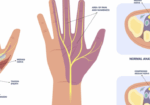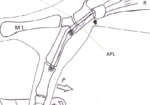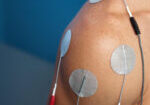Pediatric Hand Development as it relates to Hand Therapy
Filed under Uncategorized
Pediatric Hand Therapy and Hand Development
by Chelsea Gonzalez
It is essential to have an understanding of the major milestones of grasp and upper extremity development when working with younger kiddos so that therapy complements the changes naturally occurring in the brain at each age-level. It is important that babies and toddlers progress through each stage of hand development in a sequence so that neural pathways can be built for later in life. However, the timing of this progression can be flexible. The general progression (and timeline) of upper extremity development looks like this:
While a general understanding of developmental progression is essential, knowledge of more detailed milestones is important to have on hand for those times when a young patient schedules an evaluation. A few excellent overviews that we use:
- Gerber, Wilks & Erdie-Lalena (2010): https://pedsinreview.aappublications.org/content/31/7/267
- Children’s Hospital of Orange County: Fine Motor Skills: https://www.choc.org/userfiles/file/Rehab-Developmental%20Milestones%20final.pdf
- Centers for Disease Control and Prevention (also available in Spanish): https://www.cdc.gov/ncbddd/actearly/milestones/index.html
Assessment and treatment of pediatric patients in a hand setting requires knowledge of the developmental progression. If a stage is missed or underdeveloped because of an injury or condition, it is the therapist’s role to provide support in that area so future skills can continue to develop naturally.
If you see children in your practice, learn these milestones and become comfortable identifying them in children during the assessment process. It takes time and experience, so start practicing on kids you see in the community and in your daily life. Watching how kids move and how they use their hands is a great way to develop experience in identifying the skills and sequences of developmental milestone acquisition.
References:
Abzug, J., Kozin, S.H., & Neiduski, R. (2020) Pediatric hand therapy. St. Louis, MO: Mosby.
Case-Smith, J. and O’Brien, J.C. (2015). Occupational therapy for children and adolescents (7th ed.). St. Louis, MO: Mosby.
1 Comment
Leave a Comment
More To Read
Carpal Tunnel Release: Outcomes of Pediatric and Adolescent
Rapid Review. Outcomes of pediatric and adolescent carpal tunnel release based on etiology. Velicki, K., Goldfarb, C. A., Roberts, S., & Wall, L. B. (2021). Outcomes of pediatric and adolescent carpal tunnel release. The Journal of Hand Surgery, 46(3), 178-186. The Skinny: Less than 1% of pediatric carpal tunnel is idiopathic in nature, compared to…
Read MoreA Better De Quervain’s Tenosynovitis Test
J. F. Goubau, L. Goubau, A. Van Tongel, P. Van Hoonacker, D. Kerckhove, B. Berghs (2013).The wrist hyperflexion and abduction of the thumb (WHAT) test: a more specific and sensitive test to diagnose de Quervain tenosynovitis than the Eichhoff’s Test. J Hand Surg Eur Vol. 2014 Mar; 39(3): 286–292. Published online 2013 Jan 22. doi:…
Read MoreSensitivity and Specificity in Thoracic Outlet Syndrome (TOS) Tests in Hand Therapy
By: Mikayla Murphy Sensitivity and Specificity in Thoracic Outlet Syndrome (TOS) Tests in Hand Therapy Thoracic outlet syndrome (TOS) describes the compression of nerves, arteries, and veins as they pass through the thoracic outlet. Compression can occur at the interscalene triangle, the costoclavicular triangle, and the subcoracoid space (Physiopedia, n.d.). There are three types of…
Read MoreThe Use of Neuromuscular Electrical Stimulation with Upper Extremity Paralysis
The Use of Neuromuscular Electrical Stimulation with Upper Extremity Paralysis By: Mikayla Murphy Martin, R., Johnston, K., & Sadowsky, C. (2012). Neuromuscular electrical stimulation–assisted grasp training and restoration of function in the tetraplegic hand: A case series. The American Journal of Occupational Therapy, 66(4), 471-477. https://doi.org/10.5014/ajot.2012.003004 The Skinny The purpose of the study was to…
Read MoreSign-up to Get Updates Straight to Your Inbox!
Sign up with us and we will send you regular blog posts on everything hand therapy, notices every time we upload new videos and tutorials, along with handout, protocols, and other useful information.







Thank you. What are the best assessment tools in your opinion other than clinical observation for neurological development of hands from birth until 14 months?